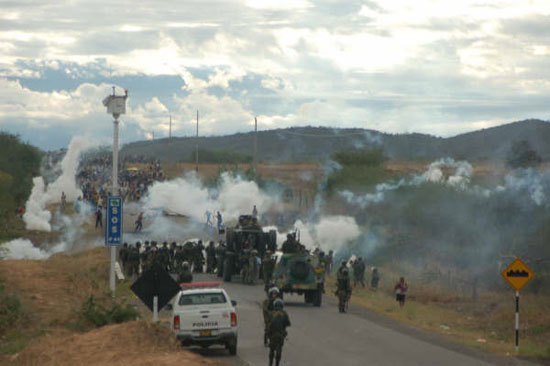
Sometimes researchers are blamed of being alarmists stirring up fears of a fictional dystopia by the business-as-usual crowd. But it seems a forewarning of conflict over oil in Peru is proceeding according to exactly such a warning. The news first...
40+ dead at protest
In extension of free trade agreements the Peruvian government has plans for 'developing' the Amazon homelands of many indigenous communities - opening it for oil, mineral, logging, and agricultural exploitation. Locals have been protesting some of these initiatives claiming they are unconstitutional and in violation of the UN Declaration on the Rights of Indigenous Peoples. When police intervened fighting erupted. Body counts wary; one is as high as 81.
President Alan Garcia Perez is claimed to have been behind a massacre on suspects of being Maoist guerrillas in 1986. A former army colonel turned politician is siding with the protesters. An arrest warrant has been issued on protest leader Alberto Pizango who has gone into hiding.
Sources: Upside Down World / 50 Days of Protest and One Massacre in the Peruvian Amazon | Peruanista blog | The New York Times / 9 Hostage Officers Killed at Peruvian Oil Facility | AP / 9 more police killed in Amazon protests in Peru | AP / At least 31 killed in Peru Amazon clashes | Mongobay / Oil or Death in the Amazon
Peer reviewed prophesies
A 2008 paper on PLoS ONE discussed this ongoing and accelerating exploitation in "the most species-rich part of the Amazon". From the paper:
No, it need not. But it just did. Heed the warnings of those who reason with statistics and logic.
Finer, M., Jenkins, C., Pimm, S., Keane, B., & Ross, C. (2008). Oil and Gas Projects in the Western Amazon: Threats to Wilderness, Biodiversity, and Indigenous Peoples PLoS ONE, 3 (8) DOI: 10.1371/journal.pone.0002932
Photo credit: Independent Journalist via Amazon Watch
Recommended Comments
Join the conversation
You can post now and register later. If you have an account, sign in now to post with your account.